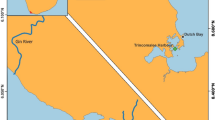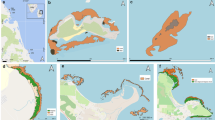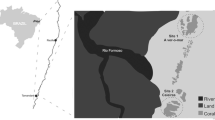Abstract
We examined coral reef communities at 11 sites within Mafia Island Marine Park using a point count method for substrate and visually censused belt transects for fish populations. Multivariate ordinations showed that the benthic habitat differed among reefs. The patterns were mainly attributed to variations in depth, hydrodynamics and benthic composition. In total, the substratum was dominated by dead coral (49%) and algae (25%), with a live coral cover of only 14%. Three hundred and ninety-four fish species belonging to 56 families were recorded. According to MDS-ordinations and RELATE procedures, fish assemblage composition varied among sites in concordance with the habitats provided. Sites with highest proportion of dead coral exhibited highest degree of dispersion in the multivariate ordinations of fish assemblages. Stepwise multiple regression was used to determine the proportion of variance among sites which could be explained by depth, exposure, rugosity, substrate diversity, branching substrate, live coral cover, dead coral cover and different types of algae. The results showed that habitat variables explained up to 92% of the variation in species numbers and in total, and taxon-specific, abundance. Live coral cover was the foremost predictor of both numerical and species abundance, as well as of corallivores, invertivores, planktivores and of the families Pomacentridae, Chaetodontidae and Pomacanthidae. Our results suggest that habitat characteristics play a dominant role in determining fish assemblage composition on coral reefs.
Similar content being viewed by others
References
Adjeroud, M., Y. Letourneur, M. Porcher & B. Salvat, 1998. Factors influencing spatial distribution of fish communities on a fringing reef at Mauritius, S.W. Indian Ocean. 1998. Envir. Biol. Fish. 53: 169-182.
Barnes, J., D. J. Bellamy, D. J. Jones, B. Whitton, E. Drew, L. Kenyon, J. N. Lythgoe & B. R. Rosen, 1971. Morphology and ecology of the reef front of Aldabra. Symp. Zool. Soc. Lond. 28: 87-114.
Bell, J. D. & R. Galzin, 1984. Influence of live coral cover on coral-reef fish communities. Mar. Ecol. Prog. Ser. 15: 265-274.
Bergman, K. C., M. C. Öhman & S. Svensson, 2000. Influence of habitat structure on Pomacentrus sulfureus, a western Indian Ocean reef fish. Envir. Biol. Fish. 59: 243-252.
Bergman, K. C. & M. C. Öhman, 2001. Coral reef community structure in Zanzibar, Tanzania. In Richmond, M. D. & J. Francis (eds), Marine Science Development in Tanzania and Eastern Africa. Proc. 20th Anniversary Conference on Advances in Marine Science in Tanzania: 263-275.
Beukers, J. S. & G. P. Jones, 1998. Habitat complexity modifies the impact of piscivores in a coral reef fish population. Oecologia 114: 50-59.
Björk M, S. M. Mohammed, M. Björklund & A. Semesi, 1995. Coralline algae, important coral-reef builders threatened by pollution. Ambio 24: 502-505.
Bouchon, C., 1981. Quantitative study of the scleractinian coral communities of a fringing reef of Réunion Island (Indian Ocean). Mar. Ecol. Prog. Ser. 4: 273-288.
Burgess, W. E., H. R. Axelrod & R. E. Hunziker III, 1990. Dr Burgess Atlas of Marine Aquarium Fishes. T.F.H. Publications Inc. U.S.A.
Caley, M. J., M. H. Carr, M. A. Hixon, T. P. Hughes, G. P. Jones & B. A. Menge, 1996. Recruitment and the local dynamics of open marine populations. Ann. Rev. Ecol. Syst. 27: 477-500.
Carpenter, K. E., R. I. Miclat, V. D. Albaladejo & V. T. Corpuz, 1981. The influence of substrate structure on the local abundance and diversity of Philippine reef fishes. Proc. Fourth Int. Coral Reef Symp., Manila 2: 497-502.
Caswell, H. & J. E. Cohen, 1991. Communities in patchy environments: a model of disturbance, competition, and heterogeneity. In Kolasa, J. & S. T. A. Pickett (eds), Ecological Heterogeneity. Springer-Verlag, New York: 97-122.
Chabanet, P., H. Ralambondrainy, M. Amanieu, G. Fauré & R. Galzin, 1997. Relationships between coral reef substrata and fish. Coral Reefs 16: 93-102.
Clarke, K. R., 1993. Non-parametric multivariate analyses of changes in community structure. Aust. J. Ecol. 18: 117-143.
Clarke, K. R & M. Ainsworth, 1993. A method of linking multivariate community structure to environmental variables. Mar. Ecol. Prog. Ser. 92: 285-219.
Colgan, M. W., 1987. Coral reef recovery on Guam (Micronesia) after catastrophic predation by Acanthaster. Ecology 68: 1592- 1605.
Done, T. J., 1982. Patterns in the distribution of coral communities across the central Great Barrier Reef. Coral Reefs 1: 95-107.
Faure, G. & L. Montaggioni, 1971. Les récifs coralliens SousLe-Vent de l’île Maurice (Archipel des Mascareignes, Océan Indien): morphologie et bionomie de la pente externe. C. r. Acad. Sci., Paris 273: 1914-1916.
Findley, J. S. & M. T. Findley, 2001. Global, regional, and local patterns in species richness and abundance of butterflyfishes. Ecol. Monogr. 71: 69-91.
Fowler, A. J., 1987. The development of sampling strategies for population studies of coral reef fishes. A case study. Coral reefs 6: 49-58.
Galzin, R., 1987. Structure of fish communities of French Polynesian coral reefs. I. Spatial scales. Mar. Ecol. Prog. Ser. 41: 129-136.
Hamilton, H. G. H. & W. H. Brakel, 1984. Structure and coral fauna of East Africa. Bull. Mar. Sci. 334: 248-266.
Harmelin-Vivien, M. L. 1989. Reef Fish Community Structure: An Indo-Pacific Comparison. Ecol. Stud. 69: 21-60.
Hart, A. M., D. W. Klumpp & G. R. Russ, 1996. Response of herbivorous fishes to crown-of-thorns starfish Acanthaster planci outbreaks. II. Density and biomass of selected species of herbivorous fish and fish-habitat correlations. Mar. Ecol. Prog. Ser. 132: 21-30.
Hobson, E. S., 1991. Trophic relationships of fishes specialized to feed on zooplankters above coral reefs. In Sale, P. F. (ed.), The Ecology of Fishes on Coral Reefs. Academic Press, San Diego: 69-95.
Hourigan, T. F., T. C. Tricas & E. S. Reese, 1988. Coral reef fishes as indicators of environmental stress in coral reefs. In Soule, D. F. & G. S. Klepel (eds), Marine Organisms as Indicators. Springer Verlag, New York: 107-136.
Jennings, S., D. P. Boullé & N. V. C. Poulunin, 1996. Habitat correlates of the distribution and biomass of Seychelles’ reef fishes. Envir. Biol. Fish. 46: 15-25.
Johnstone, R. W., C. A. Muhando & J. Francis, 1998. The status of the coral reefs of Zanzibar: one example of a regional predicament. Ambio 27: 700-707.
Jones, G. P. & C. Syms, 1998. Disturbance, habitat structure and the ecology of fishes on coral reefs. Aust. J. Ecol. 23: 287-297.
Kamukuru, A. T, 2002. Effects of fishing on growth and reproduction of black-spot snapper Lutjanus fulvifamma (Pisces: Lutjanidae) on reefs of Mafia Island, Tanzania. PhD Thesis, University of Dar es Salaam.
Lewis, A. R., 1997. Effects of experimental coral disturbance on the structure of fish communities on large patch reefs. Mar. Ecol. Prog. Ser. 161: 37-50.
Lindahl, U., M. C. Öhman, & C. K. Schelten, 2001. The 1997/1998 mass mortality of corals: effects on fish communities on a Tanzanian coral reef. Mar. Poll. Bull. 42: 127-131.
Lirman, D., 1999. Reef fish communities associated with Acropora palmata: relationships to benthic attributes. Bull. mar. Sci. 65: 235-252.
Loya, Y., 1990. Changes in a Red Sea coral community structure: a long-term case history study. In Woodwell, G. M. (ed.), The Earth in Transition: Patterns and Processes of Biotic Impoverishment. Cambridge: 369-384.
Marshall, P. A. & A. H. Baird, 2000. Bleaching of corals on the Great Barrier Reef: differential susceptibilities among taxa. Coral Reefs 19: 155-163.
Mbije, N. E., G. M. Wagner, J. Francis, M. Öhman & K. C. Bergman, 2002. Patterns in the distribution and abundance of hard corals around Zanzibar Island. Ambio 31: 609-611.
McClanahan, T. R., 1994. Kenyan coral reef lagoon fish: effects of fishing, substrate complexity and sea urchins. Coral Reefs 13: 231-241.
McClanahan, T. R. & R. Arthur, 2001. The effect of marine reserves and habitat on populations of East African coral reef fishes. Ecol. Appl. 11: 559-569.
McClanahan, T. R., N. A. Muthiga & S. Mangi, 2001. Coral and algal changes after the 1998 coral bleaching: interaction with reef management and herbivores on Kenyan reefs. Coral Reefs 19: 380-391.
McClanahan, T. R., N. A. Muthiga, A. T. Kamukuru, H. Machano & R. W. Kiambo, 1999. The effects of marine parks and fishing on coral refs of northern Tanzania. Biol. Cons. 89: 161-182.
McClanahan, T. R., K. Bergman, M. Huitric, M. McField, T. Elfwing, M. Nyström & I. Nordemar, 2000. Response of fishes to whole patch reef algal reductions in Glovers Reef, Belize. Mar. Ecol. Prog. Ser. 206: 273-282.
McCormick, M. I., 1994. Comparison of field methods for measuring surface topography and their association with a tropical ref fish assemblage. Mar. Ecol. Prog. Ser. 112: 87-96.
Meekan, M. G., A. D. L. Steven & M. J. Fortin, 1995. Spatial patterns in the distribution of damselfishes on a fringing coral reef. Coral Reefs 14: 151-161.
Munday, P. L., 2000. Interactions between habitat use and patterns of abundance in coral-dwelling fishes of the genus Gobiodon. Envir. Biol. Fish. 58: 355-369.
Öhman, M. C. & A. Rajasuriya, 1998. Relationships between habitat structure and fish assemblages on coral and sandstone reefs. Envir. Biol. Fish. 53: 19-31.
Öhman, M. C., A. Rajasuriya & E. Ólafsson, 1997. Reef fish assemblages in north-western Sri Lanka: distribution patterns and influences of fishing practices. Envir. Biol. Fish. 49: 45-61.
Öhman M. C., A. Rajasuriya & S. Svensson, 1998a. The use of butterflyfishes (Chaetodontidae) as bio-indicators of habitat structure and human disturbance. Ambio 27: 708-716.
Öhman, M. C., P. L. Munday, G. P. Jones & M. J. Caley, 1998b. Settlement strategies and distribution patterns of coral-reef fishes. J. exp. mar. Biol. Ecol. 225: 219-238.
Ormond, R. F. G., J. M. Roberts & R. Q. Jan, 1996. Behavioural differences in microhabitat use by damselfishes (Pomacentridae): implications for reef fish biodiversity. J. exp. mar. Biol. Ecol. 202: 85-95.
Randall, J. E., G. R. Allen & R. C. Steene, 1990. Fishes of the Great Barrier Reef and Coral Sea. Crawford House Press, Bathurst, Australia.
Robertson, D. R. & B. Lassig, 1980. Spatial distribution patterns and coexsistence of a group of territorial damselfishes from the Great Barrier Reef. Bull. mar. Sci. 30: 187-203.
Sale, P. F., 1980. Assemblages of fish on patch reefs - predictable or unpredictable? Envir. Biol. Fish. 5: 243-249.
Sale, P.F., (ed.), 1991. The Ecology of Fishes on Coral Reefs. Academic press, San Diego.
Sano, M., 2000. Stability of reef fish assemblages: responses to coral recovery after catastrophic predation by Acanthaster planci. Mar. Ecol. Prog. Ser. 198: 121-130.
Sano, M., M. Shimizu & Y. Nose, 1987. Long-term effects of destruction of hermatypic corals by Acanthaster planci infestation on reef fish communities at Iriomote Island, Japan. Mar. Ecol. Prog. Ser. 37: 191-199
Sebens, K. P., 1990. Habitat structure and community dynamics in marine benthic systems. In Bell, S. S., E. D. McCoy & H. R. Mushinsky (eds), Habitat Structure, the Physical Arrangement of Objects in Space. Chapman Hall, London.
Shepherd, A. R. D., R. M. Warwick, K. R. Clarke. & B. E. Brown, 1992. An analysis of fish community response to coral mining in the Maldives. Envir. Biol. Fish. 33: 367-380.
Sheppard, C. R. C., 1987. Coral species of the Indian Ocean and adjacent seas: a synonymised compilation and some regional distribution patterns. Atoll Res. Bull. 307: 1-32.
Sheppard, C. R. C., A. Price & C. M. Roberts, 1992. Marine Ecology of the Arabian Region. Academic Press.
Sheppard, C. R. C., M. Spalding, C. Bradshaw & S. Wilson, 2002. Erosion vs. recovery of coral reefs after 1998 El Niño: Chagos Reefs, Indian Ocean. Ambio 31: 40–48.
Smith, M. M. & P. C. Heemstra, 1991. Smith's Sea Fishes. Southern Book Publishers, Johannesburg.
Sokal, R. R. & F. J. Rohlf, 1995. Biometry, 3rd edn. W.H. Freeman and Company, New York.
Souter, D., D. Obura & O. Lindén (eds), 2000. Coral Reef Degradation in the Indian Ocean. Status Report, CORDIO.
Spencer, T., K. A. Teleki, C. Bradshaw & M. D. Spalding, 2000. Coral bleaching in the Southern Seychelles during the 1997-1998 Indian Ocean warm event. Mar. Poll. Bull. 40: 569-586.
Springer, V. G., 1982. Pacific plate biogeography, with special reference to shorefishes. Smiths. Contr. Zool. 367: 1-182.
Talbot, F. H., 1965. A description of the coral structure of Tutia reef (Tanganyika territory, East Africa) and its fish fauna. Proc. zool. Soc. Lond. 145: 431-470.
Waldner, R. E. & D. R. Robertson, 1980. Patterns of habitat partitioning by eight species of territorial Caribbean damselfishes (Pisces: Pomacentridae). Bull. mar. Sci. 30: 171-186.
Warwick, R. M & K. R. Clarke, 1993. Increased variability as a symptom of stress in marine communities. J. exp. mar. Ecol. Biol. 172: 215-226.
Wiens, J. A. & J. T. Rotenberry, 1981. Habitat associations and community structure of birds in shrubsteppe environments. Ecol. Monogr. 51: 409-422.
Williams, I. D. & N. V. C. Polunin, 2001. Large-scale associations between macroalgal cover and grazer biomass on mid-depth reefs in the Caribbean. Coral Reefs 19: 358-366
Author information
Authors and Affiliations
Rights and permissions
About this article
Cite this article
Garpe, K.C., Öhman, M.C. Coral and fish distribution patterns in Mafia Island Marine Park, Tanzania: fish–habitat interactions. Hydrobiologia 498, 191–211 (2003). https://doi.org/10.1023/A:1026217201408
Issue Date:
DOI: https://doi.org/10.1023/A:1026217201408




